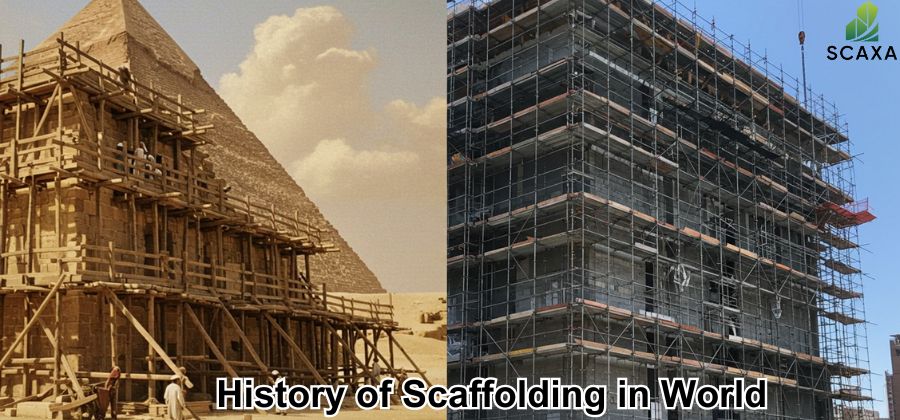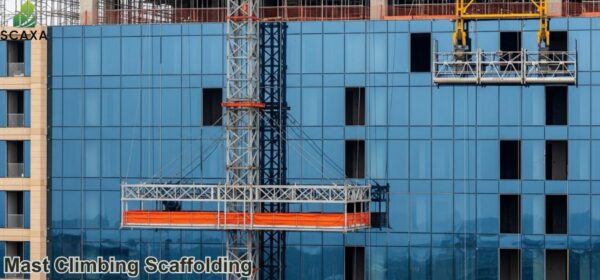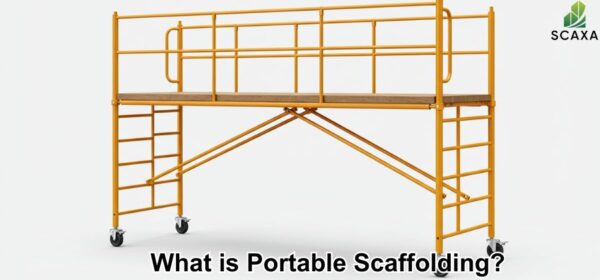People have been using scaffolding since the beginning of time. It is believed to be approximately 17,000 years old, and it has played a crucial role in the development of human structures and civilization. From the Pyramid of Giza to the building of the tallest modern skyscrapers, scaffolding has played a pivotal role in erecting everything in between. No major construction project could have been completed without it.
Nearly every culture and nation on earth has utilized some form of scaffolding. It was used for different purposes in different eras. Nations adopted the concept of scaffolding from one another and modified it to suit their specific needs. It was initially used for cave paintings, and even great painters like Michelangelo used scaffolding to paint ceilings.
The importance of scaffolding for Emirati culture and the development of the modern UAE cannot be overstated. The country experienced a rapid construction boom in the late 19th century, so the concept of scaffolding became more relevant than ever. Scaffolding provides a stable platform for workers to complete architectural projects in a timely and efficient manner. Today, we will discuss the fascinating and unique history of scaffolding and its role in the development of human civilization.
Table of Contents
Importance of Scaffolding for Construction in the UAE, including Dubai and Abu Dhabi
The United Arab Emirates is home to striking architecture and pristine infrastructure. The workers and architecture engineers work tirelessly to create the architectural marvels that the UAE is known for. Scaffolding provides safe and stable platforms for these hardworking workers to stand on and construct beautiful, sturdy buildings. It allows artisans to feel safe enough to implement their creativity and build breathtakingly beautiful skyscrapers. Therefore, stable scaffolding is the backbone of a construction project.
However, scaffolding installation is difficult and tricky. A slight oversight can lead to fatal injuries and monetary loss, which is why there are stringent legal requirements for scaffolding in the UAE. The regulation requires a skilled and properly trained supervisor to oversee the erection, modification, and dismantling of the scaffolding. Sometimes, a third-party inspection team needs to inspect scaffolding and approve it before it can be utilized.
These rules are in place to protect workers who work at high altitudes. They are susceptible to fall-related injuries that can paralyze them or even lead to fatalities. This is why many regulatory bodies in the UAE compel the stakeholders to use a safety net or protective gear. You can read more about the hazards of scaffolding later. Overall, this discussion shows the importance of scaffolding to the UAE and its construction industry. The Emirate government understands the importance of sturdy scaffolding and effective control measures in ensuring the safety of its workers and the smooth completion of construction projects.
A Brief History of Scaffolding
Let us take you back in time to explore the thrilling evolution of scaffolding.
Scaffolding in Prehistoric Times
Archaeologists have discovered evidence of scaffolding that dates back approximately 17,000 years. In southwest France, the walls of the Lascaux caves are adorned with intricately drawn murals that depict human figures, animals, and abstract symbols, offering a glimpse into prehistoric human perception and lifestyle. The sockets in the caves suggest that our ancestors likely used a scaffolding-like structure to access the cave ceilings. Hence, it is clear that the foundation of essential building techniques had already been laid 17,000 years ago, and our ancestors trusted their scaffolding-like structure enough to climb high on it. Moreover, similar sockets are found in caves worldwide.
Egypt: Construction of the Pyramid of Giza and Scaffolding

Scaffolding was likely used to construct the Pyramid of Giza, one of the Seven Wonders of the World. About 4,500 years ago, the Egyptians used scaffold-like structures to move stones and position them correctly. Approximately 2.3 million blocks of stone, each weighing between 25 and 80 tonnes, were used to erect the Great Pyramid. Of course, the stones could not be carried without the help of a structure that resembles a scaffold.
There is evidence that suggests the ramps or structures were made from wood. The wooden ramps were connected through sturdy knots. Now, you may wonder where the wood for building those ramps came from. According to a theory, the wood likely originated from Lebanon, which had lush cedar forests at that time. Pharaoh spared no effort and expense to ensure the Pyramid of Giza was a sight for ages to come. Scaffolds were also used to carve out big statues. The concept of scaffolding has indeed been a remarkable engineering achievement since the dawn of human history.
Use of Scaffolding in the Construction of the Great Wall of China
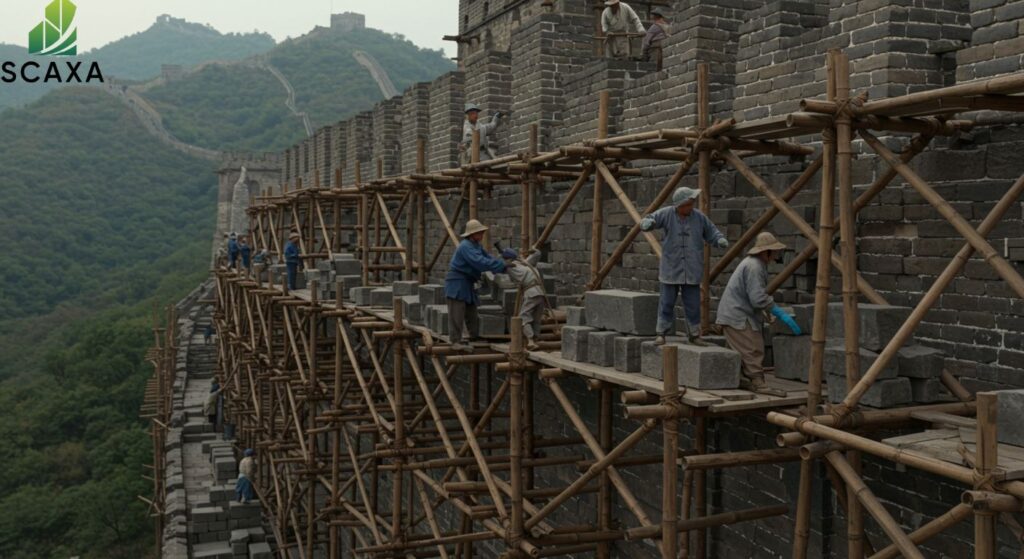
There is sufficient recorded evidence to suggest that bamboo was tied with rope in China to form devices similar to modern scaffolding. These bamboo scaffolds were used in the construction of the Great Wall of China and continued to be used in construction throughout Asia.
The Middle Ages and Scaffolding
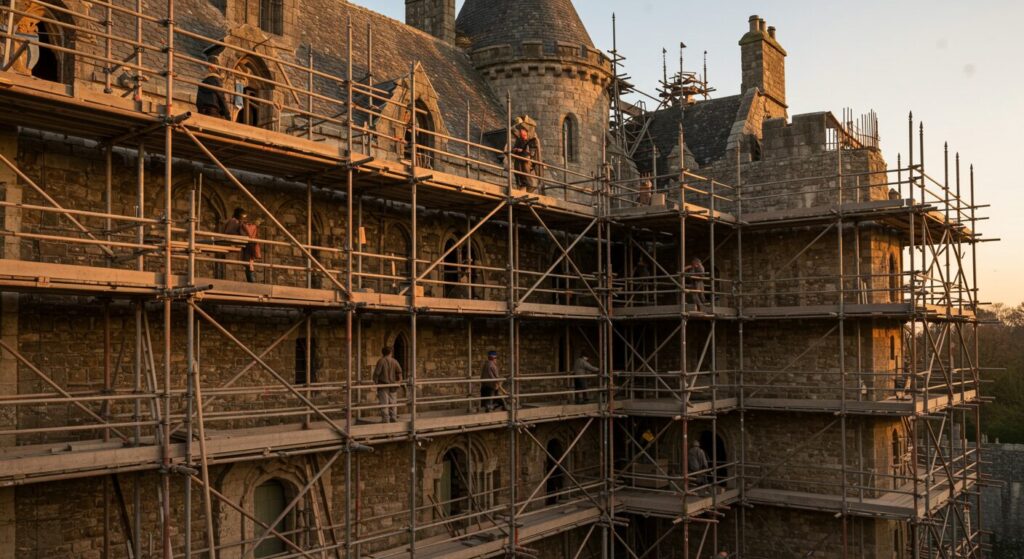
During the Middle Ages, scaffolding was used to build castles, cathedrals, and big mansions. The marvellous architecture from the Middle Ages is still known all over the world for its intricate stonework patterns and alluring details. Painters and artisans also used scaffolding to paint ceilings and create charming interiors. Michelangelo used scaffolding to paint the Sistine Chapel’s ceiling, which was at least 60 feet high.
Steel Scaffolding during the Industrial Revolution

The 19th-century Industrial Revolution led to the introduction of steel, which is sturdier than wood. As a result, steel Scaffolds were developed, which could support heavier loads and reach far higher heights. Steel scaffolds supported sky-high buildings and ambitious construction projects. The Eiffel Tower in Paris was successfully built thanks to the revolutionary steel scaffolds. The scaffolding continued to evolve as the building grew taller, becoming a pivotal part of the construction process.
Modern Scaffolds
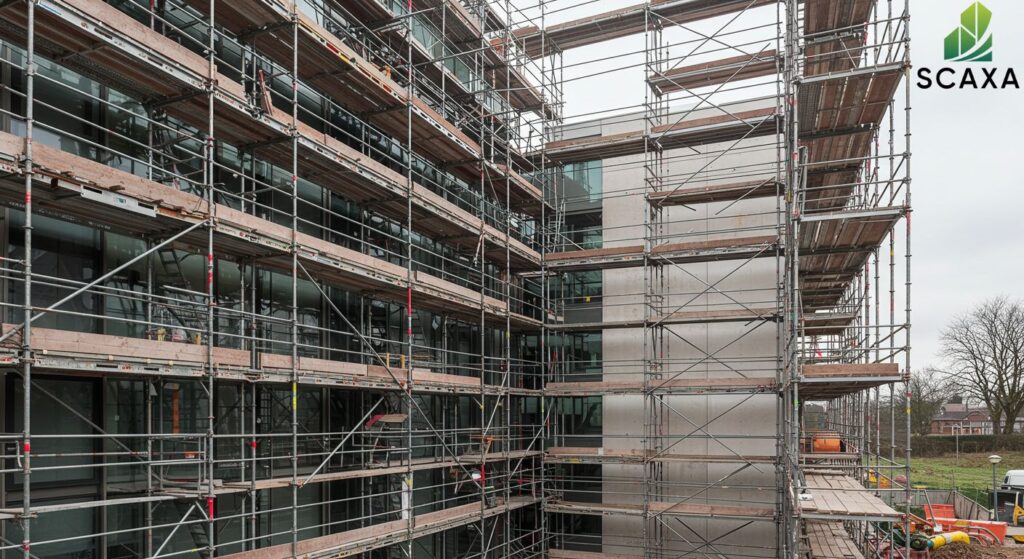
Scaffolding significantly improved in the 20th and 21st centuries with the introduction of Modular scaffolding systems and advanced, robust scaffold structures. Most modern scaffolds are stable, lightweight, and convenient. They are easy to assemble and disassemble. The tallest building in the world, Burj Khalifa in Dubai, relied on avant-garde scaffolding techniques to rise above the clouds.
As the heights of the buildings and scaffolding increased, the need for policies to protect workers and the general public became apparent. As a result, policies were implemented to ensure the well-being of workers worldwide, particularly in the UAE, where the construction industry experienced significant growth. The stringent scaffolding rules in the UAE protect the workers and passersby.
Types of Scaffolding in UAE
Today, various types of scaffolding are utilized in the UAE. The types of scaffolding are based on various factors, like the material, shape, the platforms, and the type of construction project. Steel scaffolding and aluminum scaffolding are commonly used worldwide, including in the United Arab Emirates (UAE). However, bamboo and wooden poles may be used depending on the project’s budget and requirements. The most common types of scaffolding are:
Wooden & Bamboo Scaffolding
Wooden Scaffolding is one of the oldest and earliest forms of modern scaffolding. It is commonly used outside of North America and Europe and is made from pre-cut lumber. Similarly, bamboo scaffolding is common in Southeast Asia and is made from resilient bamboo. The thick, strong, and flexible bamboo is an ideal material for bamboo scaffolding.
Single or Bricklayer scaffolding
Single or bricklayer scaffolding is commonly used for small projects and brick masonry. It is made from vertical supports (called standards) that are connected through ledgers, with putlogs attached to the walls to provide support. The distance between the two standards is within 3.4 to 3 m, and the putlogs are placed at a distance of 20 cm. Building this scaffolding is very easy and cost-effective.
Double or Mason’s Scaffolding
This scaffolding is used for stone masonry, and it is far sturdier than bricklayer scaffolding. It has two rows of scaffolds, which provide it with stability and strength. The first row is typically positioned 20-30 cm away from the wall, and the second row is placed 1m away from the first row. Putlogs support both ends of the ledgers, but they are not fixed to the walls. It also features cross braces for added support, eliminating the need for wall support. This is why Double or Mason’s Scaffolding is usually called an independent scaffold.
Spar Steel or Tubular Scaffolding
Spar Steel or Tubular Scaffolding is one of the earliest types of steel scaffolding. It is made by joining steel pipes and tubes using steel couplers. It is very easy to construct and offers more durability and superior strength. Additionally, it is far safer for workers than the types of scaffolding discussed earlier.
It utilizes steel tubes with diameters ranging from 40 mm to 60 mm, which are connected using sturdy steel couplings. It is not very economical, but it offers higher fire resistance and excellent support, making it a better option than bamboo and Bricklayer scaffolding.
Tube & Clamp Scaffolding
Tube and Clamp scaffolding is made from steel tubes and clips, which are known as couples. You simply need to connect the tubes with clamps to create long structures that support the platforms. It is a quite flexible and sturdy scaffold option. The steel is resistant to rust, corrosion, and fire, which makes it an ideal option for harsh weather conditions.
Cantilever or Needle Scaffolding
Cantilever or Needle Scaffolding does not use the ground for support as it is fixed at some height above ground level. The platform on which the stands are placed is called a needle. The needle is made of timber, projecting out from the wall. Cantilever Scaffold uses needles to support standards. This type of scaffolding can be used when the ground is slippery or uneven and cannot support the weight of the scaffolding.
Which Famous UAE Buildings Were Made with the Help of Scaffolding?
Almost every building erected in the UAE or anywhere in the world requires scaffolds. The famous buildings in the UAE that were built with the help of scaffolding are:
Burj Khalifa in Dubai

Burj Khalifa, the tallest building in the world, stands 2,722 feet (828 meters) tall, which is 300 meters taller than the second-tallest building in the world, and three times taller than the Eiffel Tower. Approximately $ 1.5 billion was spent to complete this building. It was constructed with the help of complex scaffolding and modular systems, as well as modern construction techniques.
The Leaning Tower of Abu Dhabi
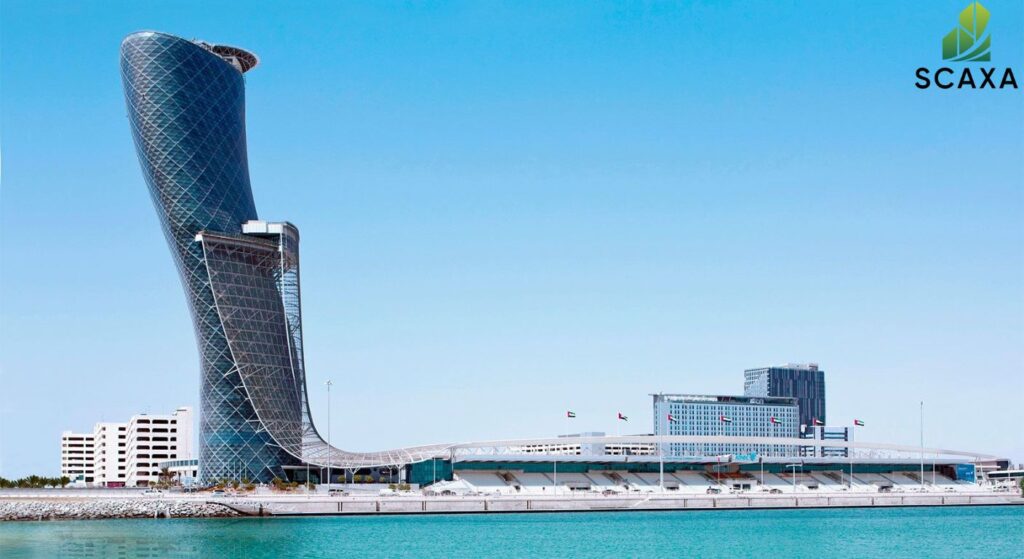
The leaning Tower of Abu Dhabi is the world’s most tilted building. Cutting-edge scaffoldings were utilized to build this marvel. It is 520 feet (160 meters) tall and inclines at 18 degrees, which is five times steeper than the Leaning Tower of Pisa. It took 4 years to build this breathtaking 35-story leaning tower.
Louvre Museum, Abu Dhabi
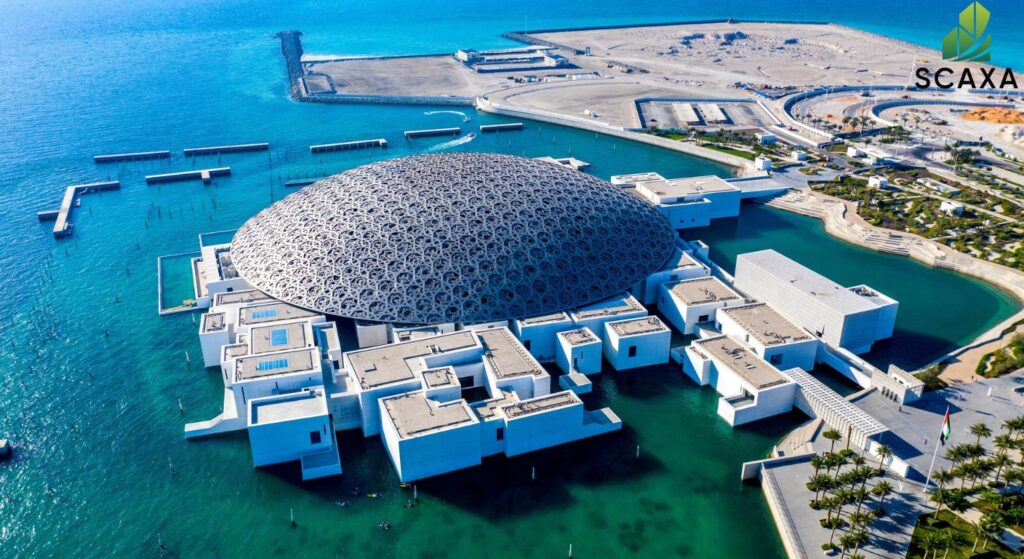
The Louvre Museum in Abu Dhabi is a remarkable modern building that features a massive dome made from complicated steelwork. Huge and complicated scaffolding structures were utilized to support the dome’s steelwork during the construction process. The scaffolding used was 40 meters high and covered an area of 17,000 square meters.
Dubai Frame in Dubai
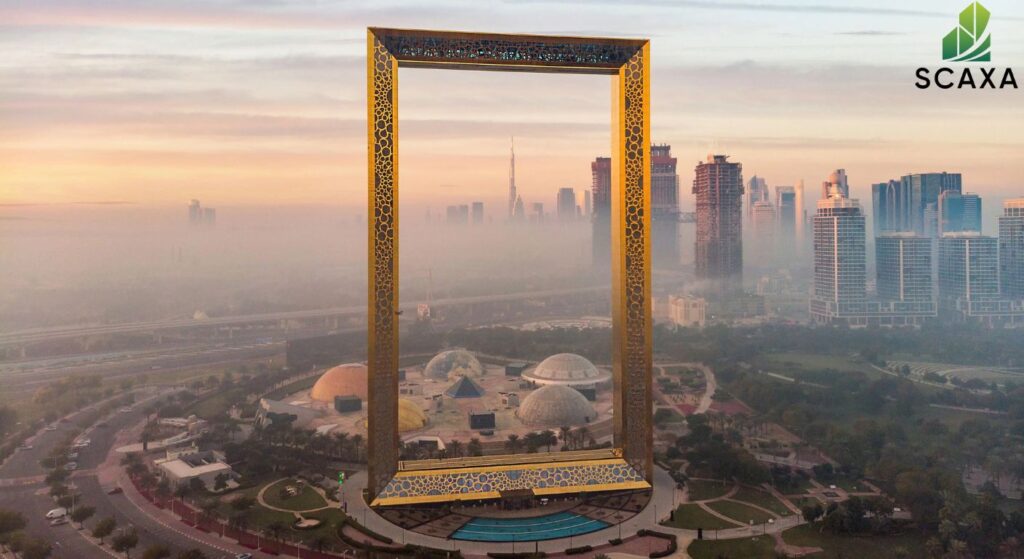
The Dubai Frame in Zabeel Park is a renowned tourist attraction due to its distinctive structure and captivating architecture. This huge frame is 150 meters tall and 93 meters wide. Heavy-duty scaffolds were used to install the golden cladding panels and the horizontal connecting bridge.
Emirates Towers, Dubai

Emirates Towers refers to the twin-tower complex in Jumeirah, Dubai. It was once the tallest building in the Middle East. This luxury complex required external scaffolding to support heavy panels and adjustable cantilever scaffolds to build its angled tops.
Scaffolding Inspection and 3rd party certification in the UAE
In the UAE, scaffolding should be erected, modified, and dismantled by a competent worker who is familiar with the legal requirements for scaffolding. The scaffolding also needs to be inspected by a third-party company approved by Dubai Municipality. Then, this third-party company will issue a certificate of approval. The scaffolding can be used by the workers after the certificate has been received. If any significant changes are made to the scaffolding structure or location, the inspection process shall be repeated.
Scaffolding Contracting works in the UAE
If you have no idea how to install scaffolding, don’t worry, because many scaffolding contractors in the UAE can help you. Scaffolding companies and contractors are well-versed in the legal requirements for scaffolding in the UAE and can efficiently erect scaffolds that comply with the relevant rules and regulations. We recommend that you hire a competent scaffolding contractor and supervisors to ensure compliance with laws and avoid legal trouble.
Summing Up
The concept of scaffolding and scaffold-like structure has existed since prehistoric times. It also continued to evolve and advance as the technology and techniques evolved. Over time, different types of scaffolding were developed based on the materials, shapes, and specific needs of construction projects. Scaffolding will undoubtedly continue to advance and improve as technology progresses and sturdier materials are developed or discovered.
Scaffolding has played an important role in the development of human civilization and culture. Sky-high buildings and marvelous architectural marvels, such as the Eiffel Tower, were erected thanks to stable scaffolds that could support workers and their tools. As the buildings and scaffolds began to rise higher, concerns grew for the well-being of workers and the general public.
Consequently, rules and regulations were developed with proper regulatory bodies to ensure that only trained and certified personnel could install and oversee the installation, modification, and dismantling of the scaffolding. The scaffolding legal requirement in the UAE is particularly strict, and compliance with these requirements is mandatory. You can hire a certified scaffolding contractor to help you if you are unfamiliar with the legal requirements for scaffolding in the UAE.



